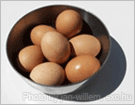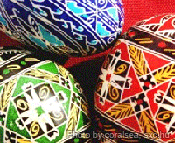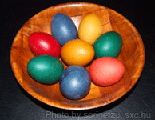Eggs have long been a symbol of life, reproduction, and fertility, since they bring about life in the form of newly hatched birds. Eggs are also tied in with the arrival of spring. Ancient Zoroastrians would celebrate the vernal equinox (first day of spring) by painting eggs. Additionally, people living in the region of Saxony, in what is now Germany, celebrated the arrival of spring by paying tribute to their goddess, Eostre. This goddess, who provided us with the word Easter, was symbolized by eggs.

Photo by jan-willem, sxc.hu
Though having roots in paganism, the egg was adopted by early Christians as a symbol of the resurrection of Jesus. According to Christian legend, Mary Magdalene arrived at the tomb of Jesus with a basket of eggs. Upon seeing Jesus resurrected, the eggs turned red. Thus, Mary Magdalene has often been represented holding a red egg, a precursor to the modern Easter egg.
Another Christian connection to the egg arises from the practice of many Christians of not eating eggs or dairy products during Lent. Since chickens would continue to lay eggs, there would be a surplus of eggs by the time Lent ended and Easter began. So, once Easter arrived, the people would celebrate by eating the many eggs they had collected.
Easter Eggs Around the World
Orthodox Christians in the Middle East and Greece were likely the first to decorate eggs for Easter, painting them bright red to represent the blood of Jesus. Since then, many different cultures have come up with their own elaborate methods of decorating Easter eggs:

Photo by coralsea, sxc.hu
- Ukraine - Ukrainian Easter eggs are known for their bright colors and intricate designs. These are made by dyeing the entire egg one light color. Then, wax is applied over the egg in a desired pattern and dyed another color. The areas under the wax remain the original color. More wax and more colors are added until one gets the desired results.
- Germany - It is a German tradition to remove the insides from an egg prior to decorating it. This is done by poking a small hole at each end and blowing the yolk out. The eggshells are then dyed and hung from trees.
- Armenia - Rather than just dyeing the eggs different colors, people in Armenia paint portraits of Jesus, the Virgin Mary, and other Christian figures.
- Russia - In the late 1800s in Russia, the House of Fabergé would created extravagant, jeweled egg replicas. These Fabergé eggs would be bought and handed out as gifts around Easter.
Decorating Your Eggs
There are many ways to decorate your Easter eggs. Before starting the decorating process, though, you should decide on what you want to do with your egg. Depending on whether you want to eat your decorated eggs, or save them for years to come, the process will be different.
- Hard-boiled Eggs - If you would like to make your Easter eggs part of your holiday meal, you'll need to hard-boil them first. If so, keep them refrigerated after decorating them. As long as you don't use acrylic paint, they should be safe to eat.
- Raw Eggs - If you wish to turn raw eggs into Easter eggs, you'll have to throw them out after the holiday. Though they may look nice, they will eventually start to rot.
- Hollowed Eggs - If you want to keep your eggs long after Easter, you can hollow them out. Poke a small hole into each end of the egg. Put one end to your mouth and blow the contents out of the shell. Then, rinse the shell with water to clean it out. After it dries, it can be decorated and kept for years to come.
TIP: Hollowed-out eggs are extremely fragile, so be extra cautious when decorating them. Because they are so fragile, it might not be the best idea for young children to work with them.

Photo by sorinetzu, sxc.hu
When you have your eggs ready, whether by hard-boiling them, hollowing them out, or leaving them as is, you can begin decorating them. The most common method involves making a solution of:
- 1/4 Teaspoon of food coloring
- 3/4 Cup of hot water
- 1 Tablespoon of white vinegar
Place the three items into a small bowl, using additional bowls for each color you want. Once the solutions are mixed, place the eggs into each bowl. The longer you let them sit, the more pronounced the color will be. When you want to take the eggs out, use a slotted spoon and put the eggs aside to dry. If desired, you can polish the dried eggs by applying a very small amount of vegetable oil to the eggs with a piece of cloth.
There are several other ways to dye Easter eggs, though the method above may just be the easiest. You can find directions for making more elaborate Easter eggs. Regardless of which method you use, dyeing Easter eggs is an integral part of the holiday. It is fun, and the finished products make a great addition to your Easter decorations. And, by making Easter eggs, you're carrying on an ancient tradition that has spread over many centuries and cultures.